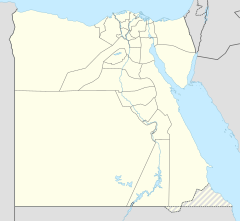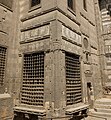Amir Qijmas al-Ishaqi Mosque
| Amir Qijmas al-Ishaqi Mosque مسجد قجماس الإسحاقي | |
|---|---|
 The main facade. | |
| Religion | |
| Affiliation | Islam |
| Region | Africa |
| Status | Active |
| Location | |
| Location | Al-Darb al-Ahmar, Cairo, Egypt |
| Geographic coordinates | 30°02′29″N 31°15′27″E / 30.0414302°N 31.257432°E |
| Architecture | |
| Type | mosque, madrasa, mausoleum |
| Style | Mamluk, Islamic |
| Completed | 1480-1481 |
| Specifications | |
| Dome(s) | 1 |
| Minaret(s) | 1 |
| Materials | stone, wood, marble, stucco |
The Mosque of Amir Qijmas al-Ishaqi (
Historical background

The mosque was likely begun in the late 1470s and completed in 1480-1481.
His mosque in Cairo was built on what was then the main road between the southern city gate, Bab Zuweila, and the Citadel of Cairo, passing through what is now known as the Al-Darb al-Ahmar district.[4] The mosque's popular name, the Mosque of Abu Hurayba (or Abu Heriba, among other spellings), is derived from the Sheikh Abu Hurayba, who was known as a wali and was buried in the domed mausoleum in 1852.[5][6] The mosque is also known today for being featured on the 50 Egyptian pound bill.[2]
Architecture

Overview and layout
The mosque is considered a remarkable example of late Mamluk architecture, especially due to the architect's ingenious arrangement of the building's different elements to make them fit into an irregular plot of land in the angle between El-Darb El-Ahmar Street and another lane joining it to the north.[2][3][4] Such creative layouts were characteristic of Mamluk buildings as Cairo's density increased and builders were forced to adapt to limited available land. The main part of the site is roughly shaped like a right triangle, between the angle of the two streets, while an annex stands across the lane to the north and is connected to the main building via a raised passage (sabat) above the street.[4][3][1]
Exterior
The main building includes the mosque itself, the domed mausoleum, the minaret, and the
The exterior of the mosque is marked by highly refined decoration exemplifying the sophisticated architectural style of
The annex to the north of the main building consists of a water trough for animals (known as a hod), enclosed by walls with further stone-carved decoration, and above this a kuttab (primary school teaching the Qur'an).[3][2] In Mamluk architecture the kuttab is more typically located above the sabil, so its location here, separated from the sabil, is uncommon.[4] The hamam (bathhouse) and ablutions area of the mosque are also located here.[1][4] The bridge passage between the two parts of the complex also has an upper level with mashrabiyya windows, suggesting this may have been used as living quarters or a residential unit.[2]
Interior

The main entrance leads to the mosque via a vestibule with a richly decorated ceiling and a passage interrupted by large skylight. This passage between the vestibule and the mosque is also joined by another passage leading from the mosque's rear entrance.[4][3] At the end of the passage, at the entrance to the mosque area, is a set of wooden sliding doors, one of only two such examples in Mamluk architecture.[3]

The mosque interior has a layout which had evolved from earlier "cruciform"
The decoration of the interior is also very rich, featuring
The mihrab area

The
The surfaces of the wooden minbar (pulpit) of the mosque are decorated with geometric sixteen-pointed star patterns emanating from round bosses. The decorative effect is achieved by different coloured inlays instead of the deep carvings of earlier minbars.[2][4]
Present-day condition
The mosque is well-preserved overall but is in need of restoration.
Gallery
-
Overall view of the complex (from the west).
-
Thesabil.
-
The raised passage linking the main building (right) and the annex (left). The annex consists of a hod (water trough for animals) on the ground floor and a kuttab (school) on the upper level.
-
View of the raised passage from the east.
-
The stone decoration around the hod (water trough).
-
The decoration on the exterior wall above the mosque's rear entrance doors.
-
The doors of the mosque, made of wood overlaid with bronze fittings.
-
One of the windows of coloured glass set into a stucco grille.
-
Close-up of the mihrab's conch (semi-dome).
-
Close-up of the minbar's decorated surface.
See also
References
- ^ a b c d بالصور: مسجد قجماس الأسحاقي الشهير بـ"أبو حريبة" وجامع الخمسين جنيه. Masrawy. Retrieved January 12, 2018.
- ^ a b c d e f g h i j k l m n o p q r s t u v w x y z aa Williams, Caroline (2018). Islamic Monuments in Cairo: The Practical Guide (7th ed.). Cairo: The American University in Cairo Press.
- ^ a b c d e f g h i j k l m n Doris Behren-Abouseif (2007). Cairo of the Mamluks: A History of its Architecture and its Culture. The American University in Cairo Press.
- ^ a b c d e f g h i j k l m n O'Kane, Bernard (2016). The Mosques of Egypt. Cairo: The American University in Cairo Press. pp. 66–70.
- ^ مسجد قجماس الإسحاقى.. شهرته «أبو حريبة».. براعة معمارية تاريخها 177 عاما.. إيوانات مزخرفة.. أسقف ملونة.. كتابات قرآنية بالخط الكوفى.. فيديو وصور. El Balad. Retrieved January 12, 2018.
- ^ Masjid Amir Qijmas al-Ishaqi. Archnet. Retrieved January 12, 2018.
- ^ بالصور.. مسجد "قجماس الإسحاقي" كرمته الدولة وأهملته وزارة الآثار. Al Wafd. Retrieved January 12, 2018.
Bibliography
- Behrens-Abouseif, Doris. Islamic Architecture in Cairo. Leiden: E. J. Brill, 1989.
- Jarrar, Sabri, András Riedlmayer, and Jeffrey B. Spurr. Resources for the Study of Islamic Architecture. Cambridge, MA: Aga Khan Program for Islamic Architecture, 1994.
















